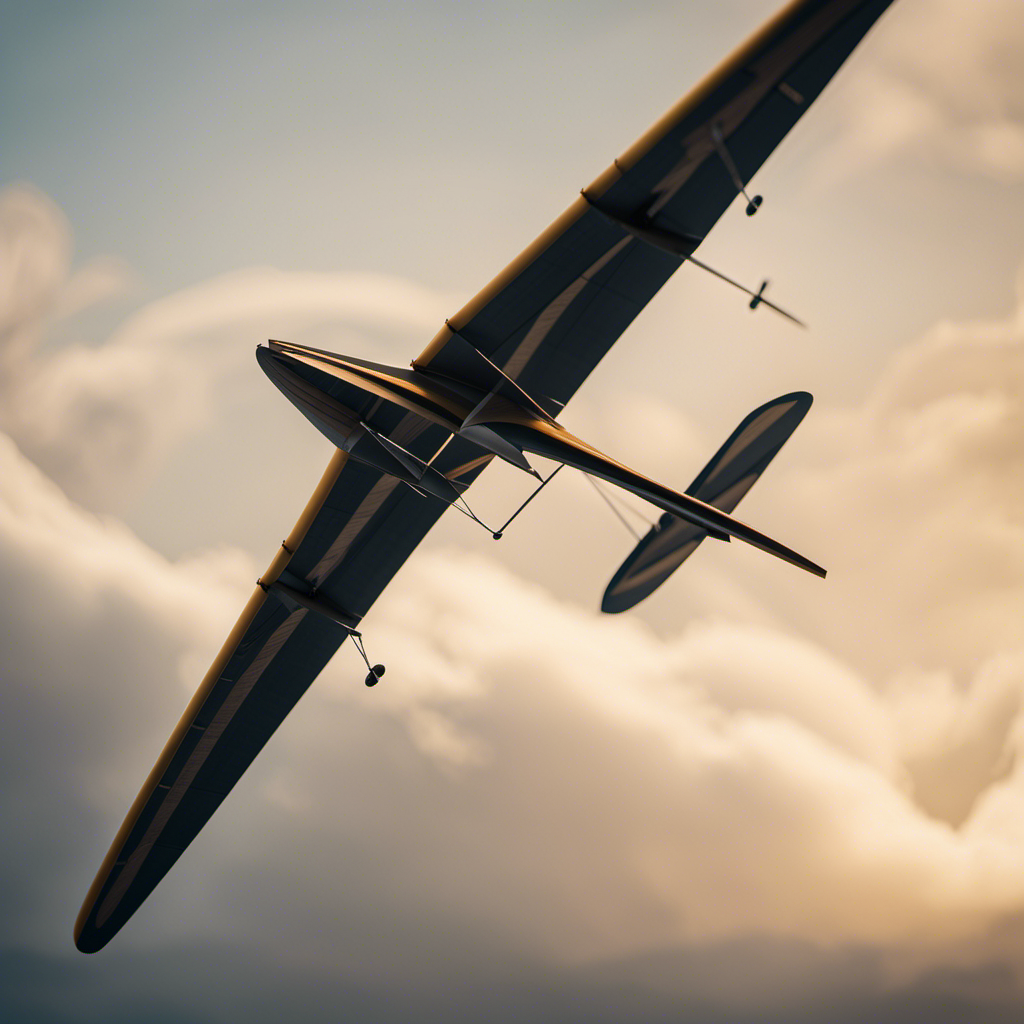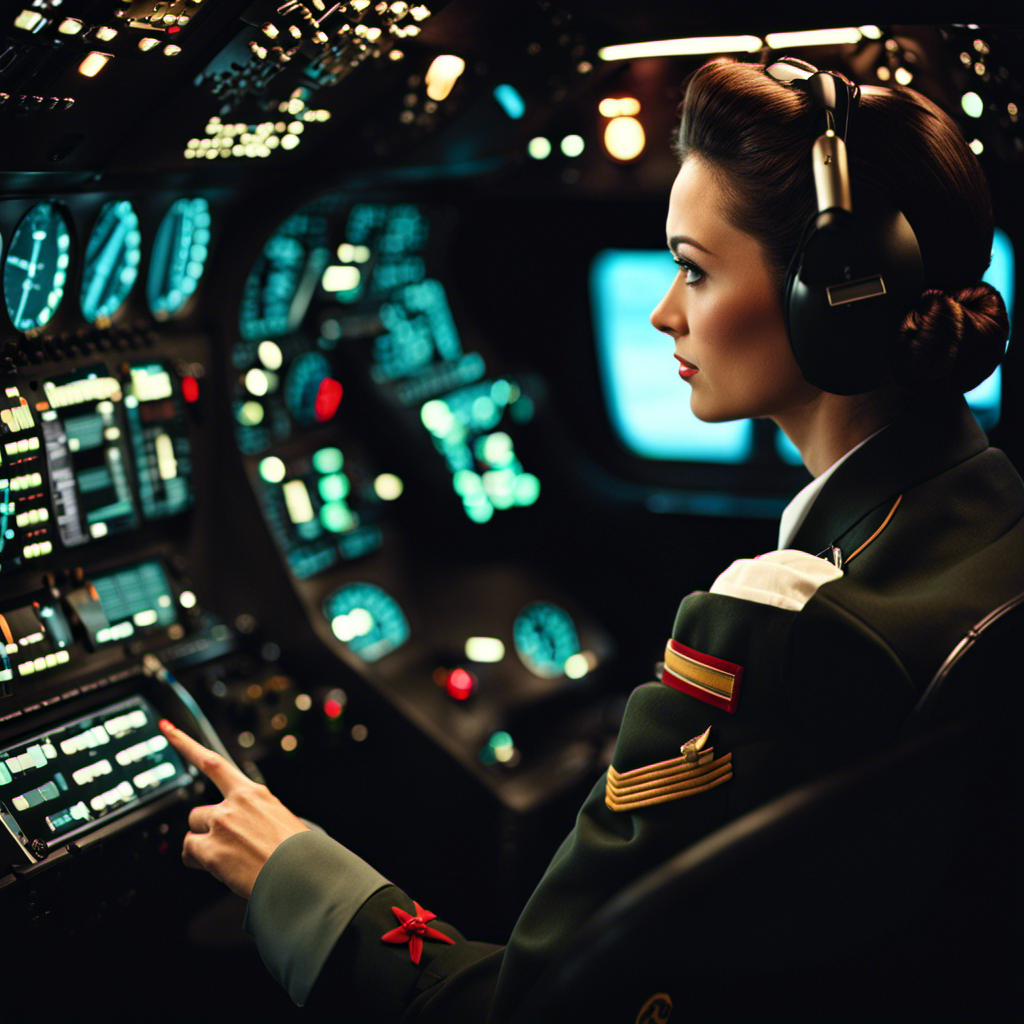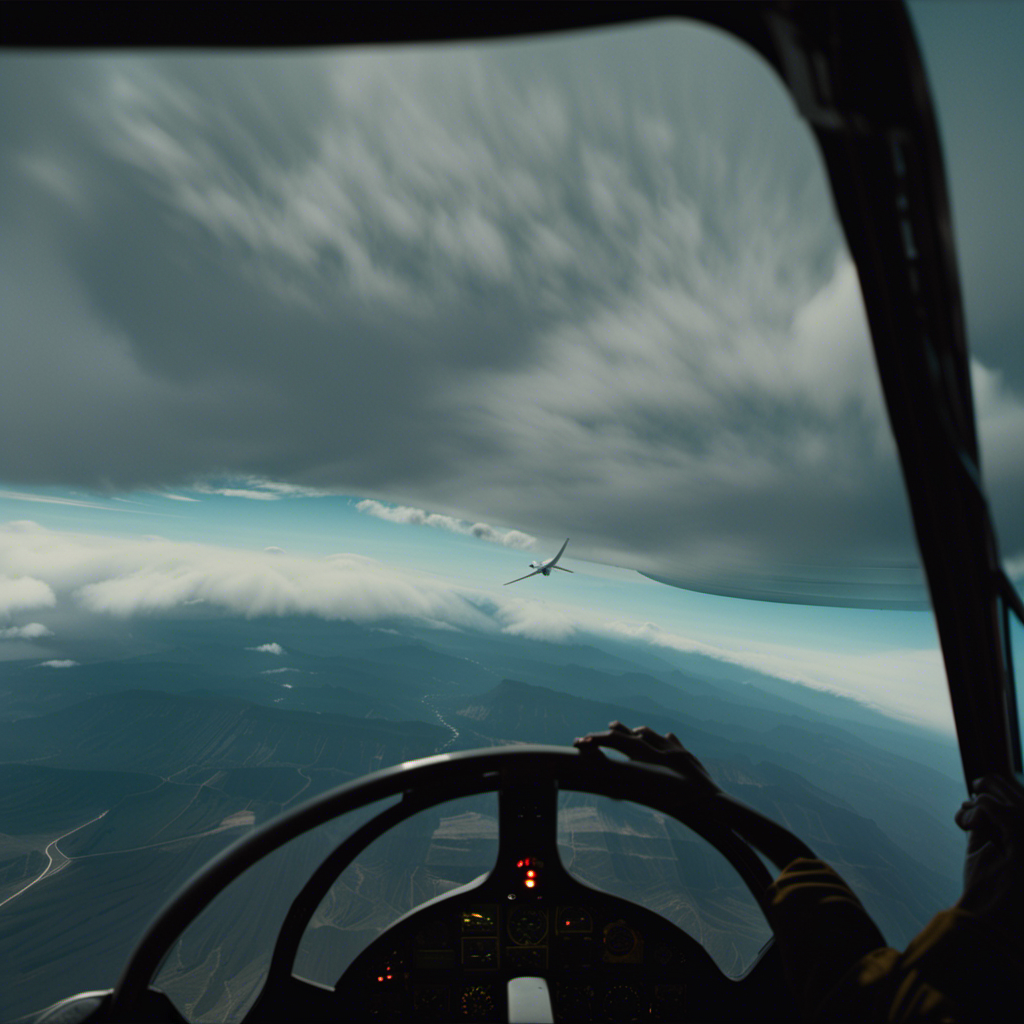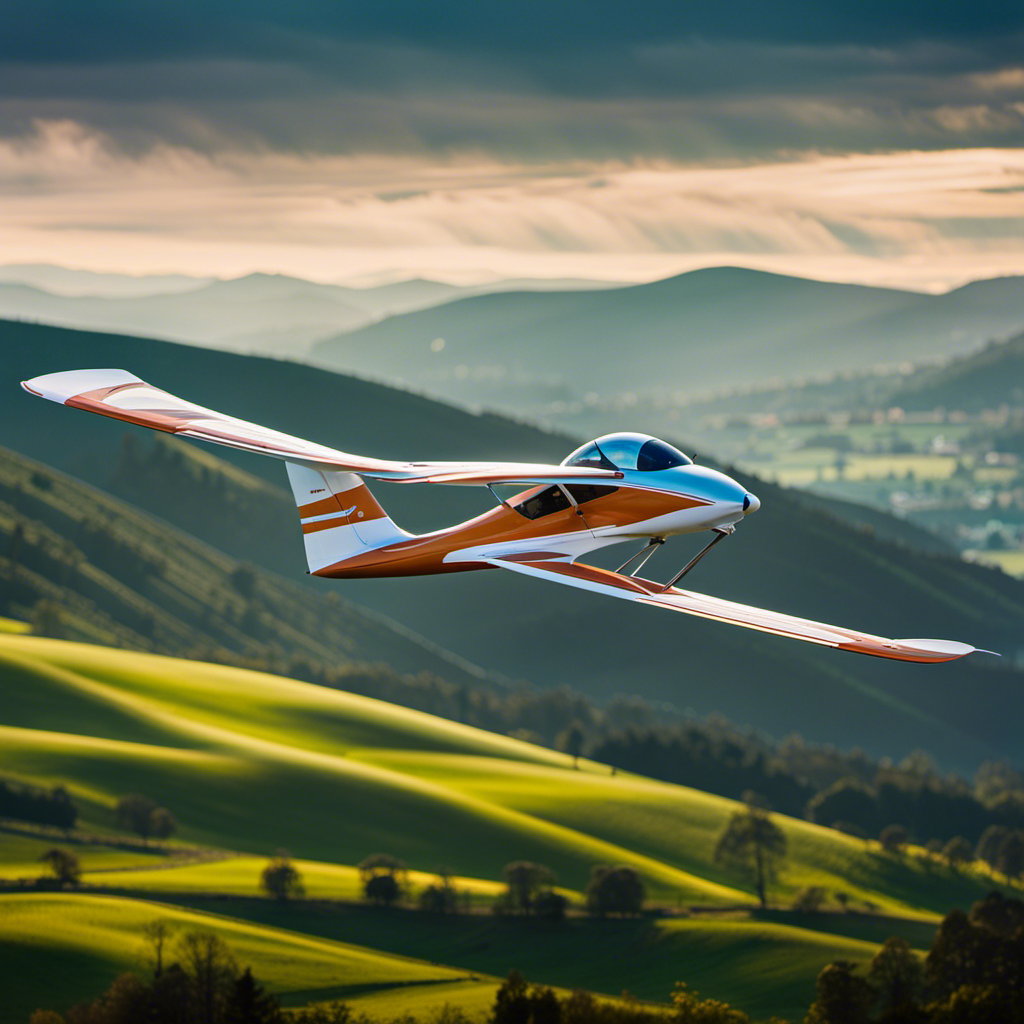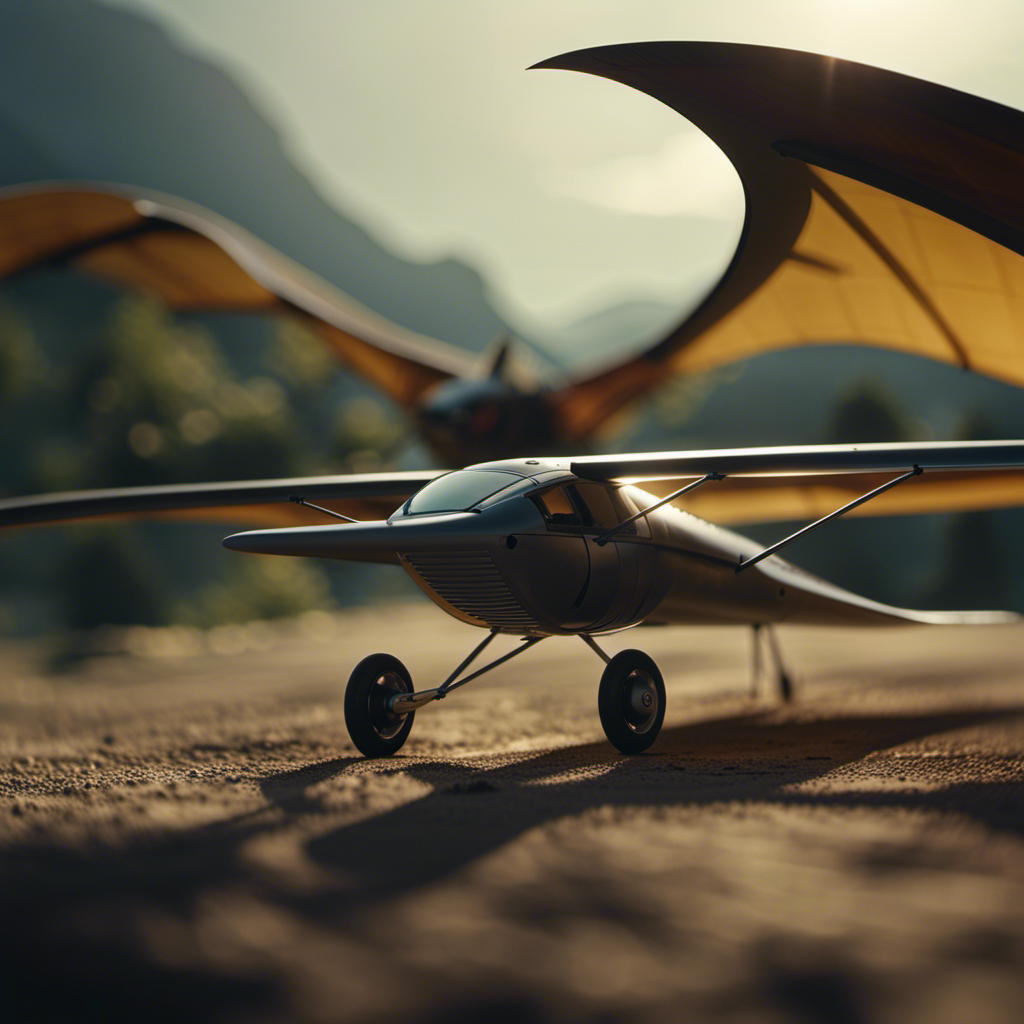I have always been intrigued by the aerodynamics of balsa wood gliders. Were you aware that the placement of the wing is essential to their flight capabilities?
In this article, we will delve into the intricacies of wing placement and explore the factors that contribute to optimal positioning. By experimenting with different wing positions, testing for stability, and understanding the importance of weight distribution, we can achieve a soaring glider.
Join me as we uncover the secrets to a well-positioned wing on a balsa wood glider.
Key Takeaways
- Wing sweep affects stability and drag, with swept-back wings offering stability at high speeds and straight wings providing lift and maneuverability at slower speeds.
- Wing dihedral impacts stability and self-leveling tendencies, with dihedral wings offering stability and flat wings providing maneuverability.
- Front wing position increases speed and reduces drag, while rear wing position enhances balance and maneuverability.
- Experimentation and testing are necessary to find the optimal wing position, balancing speed and maneuverability.
Understanding the Basics of Wing Placement
To understand the basics of wing placement, you’ll want to consider the balance and stability of your balsa wood glider. Two key factors that affect the performance of the glider are the wing sweep and the wing dihedral.
The impact of wing sweep refers to the angle at which the wings are positioned in relation to the fuselage. Swept-back wings, where the leading edge is angled backward, can provide better stability and reduce drag. This is particularly beneficial for gliders that need to achieve high speeds. On the other hand, straight wings, where the leading edge is perpendicular to the fuselage, offer better lift and maneuverability at slower speeds.
The effect of wing dihedral is related to the angle at which the wings are tilted upward from the fuselage. Dihedral wings, where the wings are angled upwards, provide increased stability and self-leveling tendencies. This is particularly useful for gliders that need to maintain a steady flight path. Flat wings, where the wings are parallel to the fuselage, offer improved maneuverability and control.
Understanding the impact of wing sweep and the effect of wing dihedral is crucial for achieving optimal wing placement. These factors will help you determine the most suitable wing position for your balsa wood glider, ensuring it achieves the desired balance and stability in flight.
Now let’s delve into the other factors to consider for optimal wing position.
Factors to Consider for Optimal Wing Position
One important aspect to consider for finding the best spot for the wing on the balsa glider is the weight distribution.
The position of the wing plays a crucial role in determining the glider’s speed and maneuverability.
When the wing is positioned closer to the front of the glider, it allows for a more forward weight distribution. This results in increased glider speed as the center of gravity is shifted forward, reducing drag.
On the other hand, placing the wing towards the rear of the glider creates a more balanced weight distribution, enhancing maneuverability. The glider becomes more responsive to control inputs, making it easier to perform precise maneuvers such as loops or turns.
It is important to note that finding the optimal wing position is a delicate balance between speed and maneuverability. Experimenting with different wing positions allows for fine-tuning the glider’s performance.
Experimenting with Different Wing Positions
Experimenting with different wing positions allows for fine-tuning the glider’s performance, finding the optimal balance between speed and maneuverability. The effect of wing sweep on glider performance is a crucial factor to consider. By adjusting the sweep angle of the wings, the glider’s aerodynamic characteristics can be modified.
Swept-back wings reduce drag and improve high-speed performance, but they can also decrease stability. On the other hand, swept-forward wings enhance stability but may increase drag. It is essential to strike a balance between these factors to achieve the desired flight characteristics.
Additionally, the influence of wing dihedral on glider stability should not be overlooked. Dihedral refers to the upward angle of the wings from the horizontal axis. A higher dihedral angle increases the glider’s stability by providing inherent stability during flight. However, excessive dihedral can result in reduced maneuverability. Finding the optimal dihedral angle is crucial to ensure stability without sacrificing maneuverability.
To test and adjust for stability, various wing positions can be evaluated through flight testing. By observing the glider’s behavior in flight, adjustments can be made to the wing position to enhance stability. This process involves making small alterations and carefully monitoring the glider’s response. Ultimately, the goal is to find the optimal wing position that achieves the desired stability and maneuverability for the glider.
With a thorough understanding of the effect of wing sweep and wing dihedral, along with the ability to experiment and fine-tune the wing position, it becomes possible to optimize the glider’s performance and achieve an ideal balance between speed and maneuverability.
Testing and Adjusting for Stability
When testing and adjusting for stability, you can observe the behavior of the glider in flight to make small alterations and carefully monitor its response. There are several testing methods you can use to analyze the results. One approach is to fly the glider in different wind conditions to see how it performs. By launching the glider multiple times and recording its flight path, you can gather data on its stability.
Another method is to make incremental changes to the wing position and observe the effects on the glider’s flight. This can involve adjusting the angle of attack or the position of the center of gravity. By carefully analyzing the results of these tests, you can determine the optimal wing position for stability.
Transition into the subsequent section about ‘the importance of balancing weight distribution’:
In addition to testing and adjusting for stability, it is also crucial to consider the importance of balancing weight distribution in achieving optimal glider performance.
The Importance of Balancing Weight Distribution
It’s crucial to consider how weight is distributed in order to achieve optimal performance in the glider. Weight distribution techniques and wing placement strategies play a significant role in determining the flight characteristics of the glider. Here are some key points to keep in mind:
-
Center of Gravity (CG): The CG should be located slightly forward of the wing’s center of lift. This helps to maintain stability and prevent the glider from stalling or diving.
-
Wing Position: Placing the wings closer to the front of the glider increases stability, while positioning them towards the back enhances maneuverability. Finding the right balance is essential for achieving the desired flight performance.
-
Tail Weight: Adjusting the weight in the tail section can also influence the glider’s flight. Adding weight to the tail can increase stability, while reducing weight can make the glider more responsive to control inputs.
By carefully considering these weight distribution techniques and wing placement strategies, you can fine-tune your glider’s flight performance.
Next, we will explore how to further optimize the glider’s flight characteristics through additional adjustments and modifications.
Fine-Tuning Your Glider’s Flight Performance
When it comes to fine-tuning the flight performance of a glider, there are several key points to consider.
First, adjusting the wing incidence can greatly impact the glider’s stability and lift.
Second, adding wingtip plates can help improve the glider’s maneuverability and reduce drag.
Finally, modifying the wing shape, such as adding dihedral or camber, can further enhance the glider’s performance by optimizing its lift and stability.
These three techniques are essential for maximizing the flight capabilities of a glider and achieving optimal performance in various conditions.
Adjusting Wing Incidence
Adjusting the wing incidence can greatly impact the flight performance of the balsa wood glider. Wing incidence refers to the angle at which the wing is attached to the fuselage. By changing the wing incidence, we can manipulate the lift generated by the wing and, consequently, affect the glider’s stability and overall flight characteristics.
Increasing the wing incidence will increase the lift, resulting in a glider that flies higher and longer. However, this may also make the glider less stable, as the increased lift can cause the glider to pitch up or stall.
On the other hand, decreasing the wing incidence will reduce the lift, making the glider more stable but sacrificing some of its flight performance. Finding the right balance is crucial for optimal flight performance.
To further enhance the glider’s performance, we can also consider adding wingtip plates, which will be discussed in the next section.
Adding Wingtip Plates
To enhance your glider’s performance, you can consider adding wingtip plates. These plates are small extensions that are attached to the outer edges of the wings. By doing so, you can significantly improve the aerodynamics of your glider.
Wingtip plates effectively reduce drag by minimizing the airflow disruptions that occur at the wingtips. They work by preventing the formation of vortices, which are swirling currents of air that can increase drag and reduce overall lift.
By reducing drag, your glider will be able to maintain a higher speed and achieve longer flight times. Additionally, wingtip plates can also improve stability and control, allowing for more precise maneuvers.
Now, let’s move on to the next section and explore the benefits of modifying the wing shape.
Modifying Wing Shape
If you want to improve your glider’s performance, you should consider modifying the shape of its wings. By making specific adjustments, you can enhance lift and reduce drag, resulting in better overall flight characteristics.
Here are three modifications that can help you achieve these goals:
-
Increase wing aspect ratio: By elongating the wingspan and reducing the chord width, you can improve lift efficiency. This allows the glider to generate more lift while minimizing drag.
-
Add wing camber: Modifying the curvature of the wing surface can enhance lift production. By creating a convex shape on the top surface and a concave shape on the bottom surface, you can optimize airflow and increase lift.
-
Incorporate winglets: These small vertical extensions at the wingtips can reduce the formation of vortices, which cause drag. Winglets help to improve aerodynamic efficiency, resulting in reduced drag and improved glider performance.
Learning from Experienced Glider Builders
When building your balsa wood glider, experienced glider builders can provide valuable insights. They have a wealth of knowledge about achieving maximum lift and optimizing the glide ratio through wing placement.
Expert tips for achieving maximum lift involve carefully shaping the wings to create the right amount of lift force. This can be achieved by ensuring the wings have a symmetrical airfoil shape and a slight upward angle of attack. Additionally, the wings should have a high aspect ratio, meaning they are long and narrow, to reduce drag and increase lift.
Achieving an optimal glide ratio through wing placement is also crucial. This involves finding the right balance between the center of gravity and the wing’s location. The center of gravity should be slightly forward of the wing’s midpoint. This helps maintain stability during flight and allows for smoother gliding. The wing’s placement should also consider the dihedral angle, which is the upward angle of the wings from the horizontal plane. A small dihedral angle helps improve stability and enhances the glider’s turning ability.
By learning from experienced glider builders, you can gain valuable insights into these expert tips for achieving maximum lift and optimizing the glide ratio through wing placement. Avoiding these common mistakes can lead to a more successful and enjoyable balsa wood glider-building experience.
Next, let’s explore some common mistakes to avoid when building your balsa wood glider.
Common Mistakes to Avoid
After gaining insights from experienced glider builders, it is important to understand the common mistakes that can hinder the performance of a balsa wood glider. Achieving stability is crucial for successful flight, and avoiding these errors is key to attaining that stability.
One common mistake is improper wing positioning. Placing the wing too far forward or too far back can disrupt the balance of the glider, leading to instability and poor flight characteristics. It is essential to carefully measure and position the wing according to the design specifications to ensure optimal stability.
Another mistake to avoid is using too much or too little glue when assembling the glider. Excessive glue can increase the weight of the glider, negatively affecting its flight performance. On the other hand, using too little glue can result in weak joints that may come apart during flight. Finding the right balance in glue application is crucial for achieving stability.
Additionally, overlooking the importance of sanding and smoothing the surfaces can also lead to stability issues. Rough or uneven surfaces can create unnecessary drag and turbulence, affecting the glider’s performance. Proper sanding and smoothing techniques should be employed to ensure smooth airflow and optimal stability.
In the subsequent section, we will discuss the safety precautions that should be taken during glider testing, ensuring a secure environment for experimentation and evaluation.
Safety Precautions for Glider Testing
Before starting glider testing, it’s important to ensure that all necessary safety precautions have been taken. As someone who has spent years studying and working with gliders, I understand the importance of safety in this field. To ensure a successful and safe testing process, here are four key safety precautions to consider:
-
Conduct a thorough pre-flight inspection: Check the glider for any signs of damage, ensure all control surfaces are functioning properly, and confirm that the wing and tail are securely attached.
-
Choose an appropriate testing location: Find an open area with no obstacles or overhead wires that could interfere with the glider’s flight path. Consider weather conditions, such as wind speed and direction, to ensure safe testing.
-
Use proper safety equipment: Wear protective gear, including goggles and gloves, to prevent any potential injuries during the testing process. It is also essential to have a fire extinguisher nearby in case of emergencies.
-
Establish communication protocols: Before launching the glider, establish clear communication channels with any assistants or observers. This will ensure that everyone is on the same page and can respond quickly in case of an emergency.
By following these safety precautions, you can minimize risks and focus on the task at hand: optimizing glider flight control and preventing wing stall.
Once all safety measures are in place, you can move on to enjoying the rewards of a well-positioned wing.
Enjoying the Rewards of a Well-Positioned Wing
To fully experience the benefits of a well-positioned wing, you’ll find yourself soaring through the sky with a sense of freedom and exhilaration. Maximizing lift and optimizing wing design are crucial elements in achieving this thrilling experience.
When it comes to maximizing lift, the position of the wing plays a critical role. Proper wing placement ensures that the glider can generate enough lift to counteract its weight and stay airborne. By positioning the wing at the correct distance from the glider’s center of gravity, we can achieve optimal lift distribution and stability.
Wing design optimization is another key aspect to consider. The shape, size, and angle of the wing all contribute to its performance. A well-designed wing will have a streamlined shape to minimize drag and maximize lift. The wing’s angle of attack, which is the angle between the wing’s chord line and the oncoming airflow, must also be carefully adjusted to optimize lift production. Too high or too low of an angle can negatively impact the glider’s performance.
Frequently Asked Questions
How long should the wingspan of a balsa wood glider be?
The wingspan of a balsa wood glider is crucial for optimal performance. Factors to consider include lift, stability, and maneuverability. Proper wing placement and size are key to achieving desired flight characteristics.
Can I use different materials for the wings instead of balsa wood?
Different wing materials can be used instead of balsa wood, such as foam or carbon fiber. Balsa wood wings have advantages like being lightweight and easy to work with, but may lack strength compared to other materials.
What is the optimum angle of attack for the wing?
Finding the optimum angle of attack is akin to discovering the perfect balance between a tightrope walker’s grace and a trapeze artist’s daring. It is the delicate interplay of lift and drag forces that determines the glider’s efficiency and stability.
How does the weight of the glider affect the wing position?
The weight of the glider affects the wing position, which in turn impacts its stability. Proper weight distribution is crucial for optimal maneuverability and control during flight, ensuring the glider performs at its best.
Can I add additional features, such as flaps or ailerons, to improve the glider’s performance?
Adding flaps and ailerons to a balsa wood glider can enhance its performance. Flaps increase lift and control, while ailerons improve maneuverability. However, these modifications require careful planning, balancing weight, and adjusting the wing position accordingly.
Conclusion
In conclusion, the position of the wing on a balsa wood glider is a critical factor in achieving optimal performance. By understanding the basics of wing placement and considering factors such as stability and weight distribution, glider enthusiasts can experiment, test, and adjust to find the perfect position.
Learning from experienced builders and avoiding common mistakes is essential for success. Remember to take safety precautions during testing, and soon you’ll be enjoying the rewards of a well-positioned wing.
So go forth, fellow glider enthusiasts, and let your wings soar!
Orion, better known as “Jetstream,” is the voice that brings the stories of the skies to life. His fascination with aviation began at a young age, sparked by his father’s tales of flying and adventure. Orion’s journey into the world of gliding was serendipitous, and from the moment he took his first glider flight, he knew he had found his calling.
